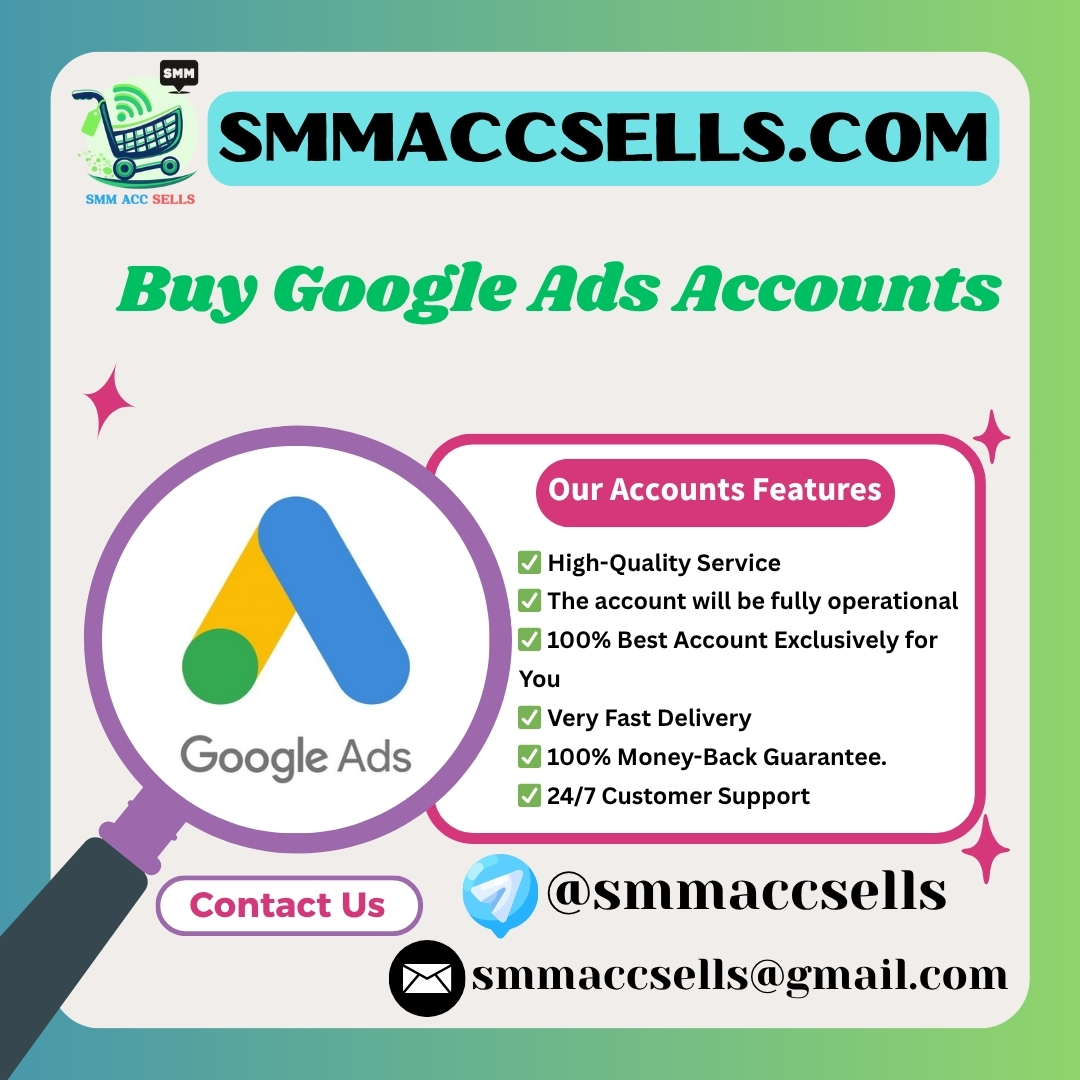Buy Google Ads Accounts with Threshold | High Spend Limit | Safe & Secure
A Google Ads account is not just a platform for spending money; it is a sophisticated, multi-layered architecture that, when properly organized, serves as the engine for a business’s digital growth. A thorough understanding of its structure – from top-level billing details to individual keywords – is a fundamental requirement for maximizing return on investment (ROI). A weak structure results in wasted budgets, data errors, and limited optimization capabilities. In contrast, a clear, logical hierarchy increases ad relevance, improves Quality Score, and ensures transparent reporting. This guide offers an in-depth look at the Buy Google Ads accounts, its core components, advanced strategies, and the important role of automation and AI.
The Foundational Hierarchy: Account, Campaign, and Ad Group
The core of Google Ads operates on a strict three-level hierarchy: accounts, campaigns, and ad groups. This design forces advertisers to segment their marketing efforts logically, so that budgets, targeting, and messaging are aligned with specific business goals.
The account is the highest level, acting as the primary container for all activity. Its settings are public and cannot be overridden by lower levels. Key account-level elements include the unique customer ID, associated email and password, billing information, and selected time zone. The time zone is crucial, as it determines the daily cycle for budget resets and reporting. The account is where conversion actions are defined and where advanced features like auto-tagging are enabled. An often overlooked feature at this level is the manager account (MCC), which is a separate type of umbrella account for agencies or large advertisers that manages multiple standard ad accounts from a single dashboard, centralizing oversight and billing. Buy Google Ads Accounts from Smmaccsells.com.
The Campaign Level: Defining Strategy and Resources
The campaign is located below the account and is the most important level for setting advertising strategies and controlling budgets. Each campaign has a single objective and a dedicated budget that controls its spending. The key setting at this level is the campaign type, which determines where the ads will appear and in what format they will be received.
Search campaigns: Focus on showing text ads on Google search results pages based on keyword matches. These are highly targeted campaigns, as users are actively searching for solutions.
Display campaigns: Target users across the vast Google Display Network using image and responsive ads. These are primarily used for brand awareness and remarketing.
Video campaigns: Run on YouTube and the Display Network, aiming to increase brand awareness, increase consideration, or generate conversions through various video ad formats.
Shopping campaigns: Important for e-commerce, these show product listing ads with images, prices, and store names directly in the SERP, driven by the Google Merchant Center feed.
Performance Max: A goal-based, automated campaign that runs across all of Google’s inventory from a single campaign, powered by AI, creative assets, and conversion goals.
Other important campaign-level settings include geographic and language targeting, ad scheduling, and, importantly, bidding strategies. This segmentation by type, geography, and budget ensures that resources are properly allocated to meet different business objectives. For example, a high-priority product should have its own campaign with a dedicated budget and a high-value bidding strategy. Buy Google Ads Accounts. Buy Google Ads Accounts

The Principle of Hyper-Relevance
Ad groups are the third and most important structural level for maximizing Quality Score (QS). An ad group should be built around a single, tightly connected theme or product category. The success of an entire Google Ads account depends on the relevance established at this level.
This structure is often described as the golden triangle of relevance:
All keywords within an ad group must be closely related to that single theme. Ad copy should dynamically reference those keywords in the title and description. Finally, the landing page should be the most specific and relevant destination on the advertiser’s website, directly addressing the user’s search intent. A weak or generic landing page immediately lowers Quality Score, no matter how good the keywords and ad copy are. The best practice is to limit ad groups to 10-20 highly relevant keywords to maintain this tight thematic focus. Therefore, to spread your message to everyone through advertising buy Google Ads accounts to grow your business from our trusted organization, our website Smmaccsells.com.
The Role of Bidding and Automation
The bidding strategy, which is set at the campaign level, dictates how aggressively Google will compete in the auction on the advertiser’s behalf. Bidding strategies fall into two main categories: manual and smart bidding.
Manual bidding (manual CPC): Gives the advertiser complete control, allowing them to set the maximum amount they are willing to bid for a click on each keyword. This requires intensive, daily management but is ideal for accounts with low data volume or specialized, high-value keywords.
Smart bidding: A suite of automated strategies that leverage Google’s AI to optimize for specific performance goals in real-time at the moment of the auction. This is the recommended approach for most established accounts, as AI can process a vast amount of signals that manual bidding cannot. Key smart bidding types include:
Target CPA (cost per acquisition): Aims to achieve the maximum number of conversions while achieving a specific target cost per conversion.
Target ROAS (Return on Ad Spend): The goal is to maximize conversion value while achieving a specific return percentage.
Maximize Conversions/Value: The goal is to achieve the highest conversions or conversion value within a set daily budget, without a specific cost target.
Modern best practices provided by Google emphasize using Smart Bidding, Broad Match keywords, and Responsive Search Ads together. This combination gives AI the ability to reach a wider range of relevant searches while optimizing bids for high-value traffic, often leading to higher conversion volume at the same cost. Buy Google Ads Accounts
Effective Google Ads management extends beyond the initial setup and requires ongoing optimization and hygiene. Higher benefit to Buy Google Ads Accounts from smmaccsells.com

1. Conversion Tracking
This is the single most important component. Without robust, accurate conversion tracking, Smart Bidding cannot blindly and optimize. Advertisers must define what a conversion is and ensure that it is reliably measured and reported in Google Ads. Enhanced Conversion is an advanced technique used to improve the accuracy of this data.
2. Negative Keywords
The process of filtering out irrelevant searches is just as important as keywords. Negative keywords prevent ads from showing on terms that are unlikely to lead to conversions. Maintaining a regularly updated negative keyword list prevents budget waste and improves the overall quality of traffic.
3. Naming Conventions
A professional Google Ads account uses a clear, consistent naming convention for campaigns and ad groups. This simple practice ensures immediate clarity for any manager, simplifies filtering, and improves at-a-glance reporting.
4. The Role of Audience Targeting
While search campaigns are keyword-driven, modern advertising makes extensive use of audiences. Audience targeting is used with keywords to inform AI and refine bidding. For display, video, and PMX campaigns, audiences become the primary targeting mechanism, allowing advertisers to reach users based on their demographics, interests, or past interactions with the business.
Conclusion: Buy Google Ads Accounts
Ultimately, a Google Ads account is more than just a simple advertising platform – it’s a living, breathing performance tool that reflects the discipline, strategy, and creativity invested in it. Every click, impression, and conversion tells a story about how effectively the account has been structured and maintained. Advertisers who achieve consistent success are those who treat Google Ads not as a set-and-forget system, but as a dynamic ecosystem that evolves with data, audience behavior, and business goals. Buy Google Ads accounts to grow your business from our trusted organization, our website Smmaccsells.com.
The foundation of an effective Google Ads strategy lies in its structure. An organized account – built on strict topical relevance, clear segmentation, and specific goals – ensures that each ad serves a purpose. When ad groups are tightly aligned with specific keywords and objectives, Google’s algorithms are better able to match ads to the right audience. This precision reduces waste, improves Quality Score, and ultimately drives a higher return on investment. Each campaign should be designed around a distinct marketing objective, whether it’s brand awareness, lead generation, or direct sales. This segmentation allows advertisers to more efficiently control budgets, bidding strategies, and creative assets.
Strategic segmentation at the campaign level is equally important. Segmenting campaigns by location, device, audience type, or product category helps advertisers tailor their messages more effectively. For example, a brand promoting both physical products and digital services can split these offerings into separate campaigns, each with its own goals and performance targets. This type of segmentation enables better control over data and ensures that optimization decisions are driven by accurate, actionable insights rather than generalized performance metrics. Buy Google Ads accounts to grow your business from our trusted and secure website Smmaccsells.com.
Another essential component is the intelligent use of Smart Bidding. Google’s machine-learning-powered bidding strategies can deliver extraordinary results—but only when fueled by accurate conversion tracking. Without clean, reliable data, even the smartest algorithms can’t optimize effectively. So advertisers need to make sure that every meaningful action – whether it’s a purchase, sign-up, or phone call – is accurately tracked and fed back into the system. Over time, Smart Bidding learns from this data to make more informed decisions, optimizing bids in real time to achieve the best possible results for each auction.
However, success in Google Ads isn’t achieved through automation alone. The human touch – the marketer’s insight, creativity, and analytical thinking – is irreplaceable. Regular performance reviews, A/B testing of ad copy, and constant refinement of landing pages ensure that the account remains fresh and competitive. A healthy Google Ads account grows organically, adapting to seasonal trends, new competitors, and changes in user behavior. Buy Google Ads Accounts
Ultimately, the success of Buy Google Ads accounts is a direct reflection of the effort, strategy, and consistency invested in its management. By adhering to the principles of strict topical relevance in ad groups, thoughtful segmentation across campaigns, and data-driven smart bidding, advertisers can build a strong, scalable foundation for sustainable growth. When managed with precision and purpose, a Google Ads account becomes more than just a marketing tool – it transforms into a powerful engine for digital success. Buy Google Ads accounts to grow your business from our trusted organization, our website Smmaccsells.com. So Buy Google Ads Accounts and enjoy it.






Reviews
There are no reviews yet.